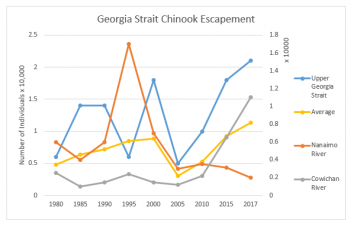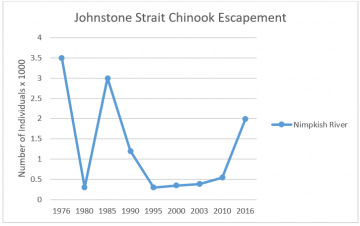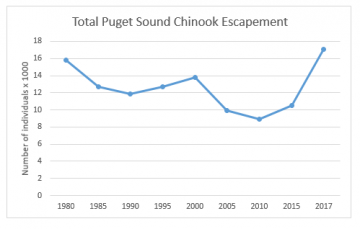Summary:
We look at data for Chinook salmon in six major regions of the Southern Resident Killer Whales (SRKW) range, and also Fitz Hugh Sound, an important part of Northern Resident Killer Whales (NRKW) range. We use and synthesize data from the Committee on the Status of Endangered Wildlife in Canada (COSEWIC), the Pacific Salmon Commission, and Fisheries and Oceans Canada. We find that in the SRKW range, most Chinook salmon stocks remain close to historical averages since the 1980s, but also experience a short term decline over the last two years. These results suggest that Chinook populations are not likely to be of robust correlate with the decline seen in the SRKW population.[1]
Why Chinook salmon?
Both SRKW and NRKW primarily feed on Chinook salmon (Oncorhynchus tshawytscha) but are also known to consume both chum (Oncorhynchu keta) and coho (Oncorhynchu kisutch) at certain times of the year (COSEWIC, 2018). In what follows we analyze `escapement’ data from the 1980s for Chinook salmon in the areas that the Southern and Northern residents frequent.
Escapement:
Escapement refers to the exact or approximated number of fish that return to the stream or river where they were born in order to spawn (Pacific Salmon Commission, 2016). We use salmon escapement data from seven primary regions where the resident killer whales are found; the Georgia Strait, Johnstone Strait, the Strait of Juan de Fuca, Puget Sound, the West coast of Vancouver Island, the Fitz Hugh Sound, and Queen Charlotte Sound. Escapement data from the Pacific Salmon Commission derives from both swim and aerial surveys, counting fences, carcass studies and most recently through Area-Under-the-Curve methodology (Pacific Salmon Commission, 2017). Fisheries and Oceans Canada collect escapement data through a variety of visual observations, angling catch, broodstock removal, dead pitch, electronic fish counters, electroshocking data, hatchery data, counting fences, tag recovery and trapping (Fisheries and Oceans Canada, 2018).
Georgia Strait:
Both SRKW and NRKW are found in and around the Georgia Strait (COSEWIC, 2008). Georgia Strait Chinook escapement rose since the 1980s and is currently at an escapement level similar to that of the mid-1990s. The steep increase followed by a steep decrease from 1980 to 1995 repeats in 2005 to 2017. While there has been a steep drop over the last two years, Chinook escapement does not reach historic lows, and does not stray from historic trends of loss and recovery. Two rivers in the Georgia Strait that are at historic lows since 1980: Nanaimo, and Harrison River. All other rivers included in this analysis see rising Chinook escapement or are relatively consistent between 1980 and 2017.


Data retrieved from: Pacific Salmon Commission, 2017
Johnstone Strait:
Both SRKW and NRKW are found in and around Johnstone Strait (COSEWIC, 2008). Johnstone Strait Chinook escapement fell since 1976, and rose after 2010. Historically, Chinook escapement levels are volatile, steep increases are typically followed by steep decreases. From 1995 until 2010, escapement level stayed relatively consistent but is now showing an upward trend. The only Chinook escapement data available for Johnstone Strait Chinook was from the Nimpkish River.

Data retrieved from: Fisheries and Oceans Canada, 2018.
Strait of Juan de Fuca:
Both SRKW and NRKW are found in and around the Strait of Juan de Fuca (COSEWIC, 2008). Current escapement is approximately equal to that in 1986, but higher than the minimum in 2005. There was a dramatic increase in 2015, and a return to the levels more like those in recent history in 2017. The only Chinook escapement data available for the Strait of Juan de Fuca was in Hoko River.

Data retrieved from: Pacific Salmon Commission, 2017.
Puget Sound:
Only SRKW are found in Puget Sound (COSEWIC, 2008). Puget Sound Chinook escapement is relatively stable since 1980, with an increasing trend since 2010. Puget Sound chinook escapement seems to be characterized be slow and minimal decreases followed by similar increases since the 1980s.


Data retrieved from: Pacific Salmon Commission, 2017
West Coast of Vancouver Island:
Both SRKW and NRKW are found around the West Coast of Vancouver Island (COSEWIC, 2008). Chinook Escapement off the West Coast of Vancouver Island has increased since 1993. Between 1993 and 2012, escapement stayed relatively consistent, experiencing only slight annual increases and decreases. Between 2012 and 2015 there was a steep increase, exceeding historical highs, followed by a steep drop from 2015 to 2017. Despite the recent decrease in escapement, current levels are still at a historical high since 1993.

Data retrieved from: Pacific Salmon Commission, 2017.
Fitz Hugh Sound:
Only NRKW are found in and around Fitz Hugh Sound. Fitz Hugh Sound Chinook Escapement fell since 1985, although current escapement is similar to that of 2000. Fitz Hugh Sound Chinook escapement seems to be characterized by steep increases followed by steep drops over short periods of time. This rapid undulation has been relatively consistent since 1985. Like other areas, Fitz Hugh Sound too experienced a historical high in 2015, followed by a steep drop to current levels, almost equaling the historical low from 2000. Note the discrepancies between the trends between the Killbella and Chuckwalla Rivers. Recall that NRKW populations are not in decline.


Data retrieved from: Pacific Salmon Commission, 2017.
Queen Charlotte Sound:
Both SRKW and NRKW are found in and around Queen Charlotte Sound. Queen Charlotte Sound Chinook Escapement is relatively consistent since 1995 and in 2017 was just slightly lower than that of 1995. Queen Charlotte Sound Chinook Escapement seems to be characterized by relatively steep and significant rises and falls with a slight deviation for a period of consistency between 2010 and 2012. While there has been a steep decrease over the past two years, the pattern emulates that of the drop been 2005 and 2010. The only Chinook escapement data available for Queen Charlotte Sound was in Skeena River.

Data retrieved from: Pacific Salmon Commission, 2017.
Please return to this blog for similar information regarding SRKW and NRKW secondary and tertiary prey, Chum and Coho salmon.
References:
COSEWIC. (2008). Assessment and Update Status Report of the Killer Whale. Committee on the Status of Endangered Wildlife in Canada.
COSEWIC. (2018). Recovery Strategy for the Northern and Southern Resident Killer Whales in Canada. Species at Risk Public Registry. Retrieved from: https://www.sararegistry.gc.ca/document/doc1341a/p1_e.cfm
Fisheries and Oceans Canada. (2018). Conservation Unit Data. NuSEDS-New Salmon Escapement Database System. Retrieved from:
https://open.canada.ca/data/en/dataset/c48669a3-045b-400d-b730-48aafe8c5ee6
Pacific Salmon Commission. (2016). FAQs. Retrieved from: https://www.psc.org/about-us/history-purpose/faqs/
Pacific Salmon Commission. (2017). Annual Report of Catch and Escapement for 2017. Joint Chinook Technical Committee Report. (18)-02
[1] Our data and references used are limited, therefore should not be taken as conclusive, but as suggestive. Data used in this review was compiled from available open-access sources, and does not offer a complete insight into salmon stocks of all rivers in the SRKW and NRKW ranges. We do not have information on changes in seasonal distribution, water quality or other determinants of fish availability. Also note that this summary does not provide a conclusion on the relationship between Orca populations and the status of Chinook stocks, but suggests that Chinook stocks in the SRKW range are likely not in distress currently.